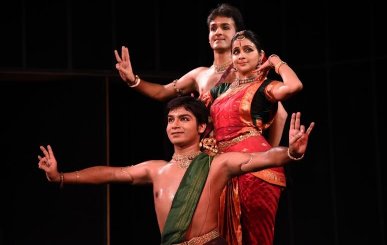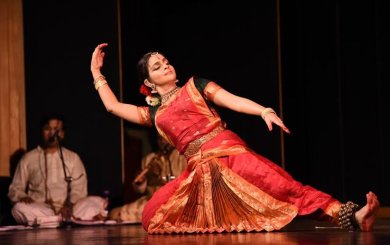
|   |

|   |
Devotion to dance, devotion through dance - Shveta Arora e-mail: shwetananoop@gmail.com Photos: Anoop Arora August 22, 2015 Under the HCL concert series, Nehha Bhatnagar, Himanshu Srivastava and Amrit Sinha performed at the IHC Delhi on the 24th of July. In the foyer leading into the auditorium, a figurine of the Devi was very creatively arranged, wrapped in a red sari surrounded by flower petals. Nehha Bhatnagar, a senior disciple of Dr. Saroja Vaidyanathan and Rama Vaidyanathan, is the founder president of Sarvam Foundation, an endeavor to celebrate the Indian performing arts through unique collaborations and festivals. That is also the thought behind them organizing free classes in Bharatanatyam for underprivileged children in government schools. Six girls from among these children from the slums were selected in June 2015 for a three week international performing arts festival in Poland, where they taught children from 20 countries Bharatanatyam and yoga. This gave these underprivileged girls a sense of confidence and pride. Himanshu Srivastava is a promising Bharatanatyam dancer trained by Saroja and Rama Vaidyanathan. Amrit Sinha is also their disciple and runs a school of his own in Lucknow 

The entire performance had an abundance of youthful energy and maturity in abhinaya. Nehha began with a devi stuti choreographed by Rama Vaidyanathan, with verses from Durga Saptashati, and music composed by GS Rajan. The goddess holds a lotus and a veena in either hand, as also many weapons in her other hands. Her vehicle is the lion. She is the destroyer of evil. Nehha showed the angry side of the devi. She holds the trishul in her hand and is the destroyer of the demon Mahishasura. She wears a necklace of the skulls of demons. At the same time, she is the mother and blesses her devotees. The attributes of shakti were portrayed effectively. The high point of the piece was the stance taken for riding the lion, the pace of it and the energy of the leaps. The second piece Pannagendrashayana was an ode to Lord Padmanabha by Maharaja Swathi Thirunal choreographed by Rama Vaidyanathan. The Lord reclines on Adishesha in the ocean of milk, for which Nehha did the reclining stance in many ways, at one point squatting and bending backwards. The bhakta pleads with the Lord to open his lotus eyes. Her pleading, full of pain, and expressions were brought out very emotively. The bhakta goes on to say that the wind too stings her. The Lord has teeth like the pearls from an oyster, the sound of the birds heighten her pain. People laugh at her and make fun of her. The arrows of Kamadeva shower her. The Lord’s lips are red like the fruit of the bimba tree. The bhakta’s eyes hover on his lips like the bee on the flower, drinking the nectar. The pitambara or the yellow cloth of the Lord looks strikingly grand on him. Finally, the pleading devotee says, “You have four arms and yet you do not embrace and hold me.” This was an intense abhinaya piece, and Nehha’s eyes expressed the pain of the bhakta, the pining and the craving. The third piece composed by Gopalakrishna Bharati in ragam Sindhubhairavi was an ode to Lord Nataraja. When he dances at the Chitasabha at the Chidambaram temple with his left foot lifted, the entire universe trembles with his moves. Adishesha who balances the earth on his head is also forced to regain balance. Amrit and Himanshu depicted the damru and agni in the Lord’s hand, Ganga flowing from his head, Shiva riding on the bull, the half moon on his head. Choreographed by Guru Saroja Vaidyanathan, the dancers were impressive in the leg lifts, the leaps, the footwork and the stances. As the lyrics were beautiful, so was the music and the abhinaya by Nehha for the Meera Bai bhajan - Kunjan van chhadi, he Madho, kahan jaaun, gun gaaun (Where shall I go after I leave you?). Meera as a devotee pleads with Krishna to keep her with him constantly. If she were to be a fish, she could caress his feet when he bathes. As a cuckoo she would sing to him when he grazes his cows, as a pearl she would adorn his neck. The depiction of the emotions did not take away from the pace of the movement and stances, some taken in broad plie. Choreographed by Saroja Vaidyanathan, the composition was in raag Yamuna Kalyani, adi talam. Finally, the trio presented a thillana, an aarti to Lord Murugan. The Lord holds a trident and rides a peacock. The dancers depicted the playing of the musical instruments and the attributes of the Lord. The performance ended with ‘Vande Mataram’ choreographed by Saroja Vaidyanathan. The orchestra had Saroja Vaidyanathan on nattuvangam, Satish Venkatesh on vocal, Thanjavur R Kesavan on mridangam and Rajat Prasanna on flute. Shveta Arora is a blogger based in Delhi. She writes about cultural events in the capital. |